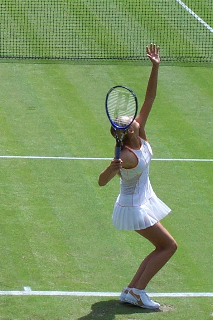Court Awareness: Playing With Your Mental Positioning System

In today’s day and age, most people have a Global Positioning System (GPS) in their car. Certainly this device has made it easier to reach your destination. All that is necessary is to input the destination and “voila” … the GPS tells you where to go. There need be little awareness of where you currently are, and no thinking or planning is necessary. So what does this have to do with tennis? Stay with me …
Let’s flash back a few years to a time when people read maps to determine how to reach a destination. There were usually three steps that were necessary: First, you needed to be aware of your current location. Second, you needed to know where you wanted to go. And third, you needed to plan the most efficient route to reach your desired destination. Then, along came an invention called “MapQuest.” This was hailed as the greatest navigation tool ever. What made it so easy was that the driver no longer needed to plot their strategy to reach the destination as it was automatically calculated. Now, our fancy GPS system not only eliminates the need to plot a strategy to reach our desired destination, but we don’t even need to be aware of our current location! The GPS automatically finds us via satellite, and calculates where we need to turn to reach our destination.
On the tennis court, we cannot turn to our GPS. However, all players have a similar, yet superior, tool of cognition when on the court, which combines the benefits of a knowledge of the destination, with the planning skills of reading a map. This tool is what I refer to as the MPS, or “Mental Positioning System.” The MPS is a human machine, run by the strongest computer in the universe—not an electronic device, but our own brain. It is activated by awareness. It requires us to examine the same three points we needed to ask when using a map: Where we are at this exact point in time, where we want to end up, and what the necessary steps are in order to reach that goal.
A mentally-sound player can employ their MPS system in both practice and in matches. When activated by awareness, the player’s MPS can tell them whether they are currently using ideal form on a stroke, what steps to take to improve technique, and lastly, where such adjustments will lead you. In a match, it can tell you where you are, where you want to be, and how to get back on track.
Fortunately, we all have MPS devices, in fact, they are hard-wired into our brain. Some players may use theirs more than others, and consequently, reap the benefits, while others may take the shortcuts that our driving GPS system uses. For example, many players simply say, “I want to win.” In other words, they input the destination like they would with a GPS. However, on the court, this shortcut will fail. The players must first be aware and able to assess the complexion of the match, patterns of play that have developed, and the score that has resulted. Once they accomplish this, they can determine what has thus far prevented the desired outcome and move toward the steps to reach that outcome.
It is the MPS which allows Roger Federer to make adjustments at any time during a match. If Roger has failed to return serves to his backhand side after a couple games, for instance, Roger’s MPS alerts him that he may need to move back, forward, or adjust the spin on his return. Then, Roger decides how he is going to accomplish this feat. Tiger Woods is known to be able to make on-the-fly adjustments, whether on the course or in front of a mirror, simply by being aware of the “feel” of his stroke.
Choosing to use your MPS is a question of whether we are aware, objective and courageous enough to admit where we are in our technical, strategic, physical or mental process. To use your MPS system properly in practice, ask yourself the following questions:
1. Where am I now on a particular element of the game?
2. Where do I want to be in a certain amount of time?
3. To get there what do I have to do?
4. Am I willing to put in the effort to do this?
5. Who can help me?
6. How will I know when I reach this goal?
To use your MPS system in matches. Ask yourself these questions:
1. What is happening at this moment?
2. What do I want to be happening?
3. What do I need to do to change things?
4. How would my position change if I made these adjustments?
5. Am I willing to make the adjustments?
Remember, when you are on the court, don’t take the shortcut by trying to use your GPS. It only works in the car. Turn on your MPS system and trust yourself to objectively assess what is happening in the match or practice session, what you want to be happening, and the best strategy to effectively reach your goal/destination. You will find that using your mind to change the course of a frustrating match in your favor is one of the most fulfilling experiences in the game.






